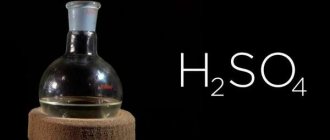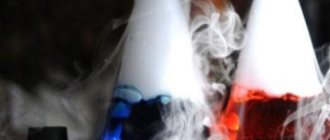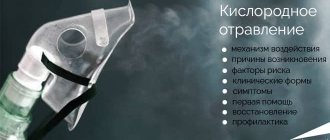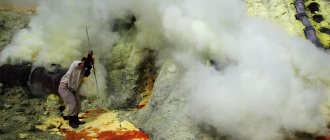Sulfuric acid can cause serious harm to health, so it is necessary to know its effect on the body and provide assistance in case of a burn.
Chemical elements have become an integral part of the life of almost every person on the planet. Today they can be found not only in serious industrial enterprises, but also in ordinary conditions - for example, in everyday life as a cleaning product or for caring for plants.
Unfortunately, not all people follow safety precautions, which creates a risk of both intoxication and serious injury as a result of chemical exposure.
Poisoning by sulfuric acid vapor, as well as being burned by it, can cause irreparable harm to health, which is why you need to know what precautions to take, how to protect yourself and your loved ones, and what to do in case of an emergency.
Sulfuric acid is a liquid that is colorless and odorless, which is why it is so dangerous for humans - under normal conditions, if safety rules are not followed, acid poisoning threatens not only human health, but also his life.
How can poisoning occur?
If a person is involved in production where sulfuric acid is used, situations in which a worker can be poisoned by the vapors of this chemical or its concentrate or solution can happen quite often. The main thing is for the victim and those around him to know what kind of help should be provided to the victim.
Poisoning itself occurs through direct, direct contact with sulfuric acid, which is in a liquid or vapor state. Regarding the question - in which case will poisoning with sulfuric acid be more severe, with poisoning with vapors or with a solution, doctors give a clear answer that in both cases the consequences are quite severe.
Symptoms of poisoning
Sulfuric acid poisoning has very characteristic symptoms, and it is impossible to confuse them with other symptoms of poisoning, for example, medications or an eating disorder. With regard to the symptoms of sulfuric acid poisoning, doctors highlight their own distinctive features - it all depends on whether the patient was poisoned by its vapors or its liquid solution.
Sulfuric acid vapor poisoning
Speaking about the symptoms of sulfuric acid vapor poisoning, we can highlight the following:
- As a result of poisoning of varying degrees of severity, the patient receives eye burns.
- The mucous membrane of the respiratory system is severely injured - burns, irritation appear, and blood may come from the nasal passages.
- The respiratory system itself also suffers - wheezing and severe sore throat are diagnosed, and spasms may develop. Spasm of the respiratory tract poses a particular danger to the victim, as does subsequent edema that develops after poisoning of the lungs and larynx - it blocks the airways and leads to asphyxia.
- The organs of the digestive system suffer - in case of sulfuric acid poisoning, the gastrointestinal tract is injured by burns, and the mucous membrane of the walls is affected. Internal bleeding may develop, which is accompanied by attacks of pain, profuse vomiting interspersed with blood.
Poisoning by sulfuric acid in its liquid form
If there is poisoning with a liquid solution or a concentrate of sulfuric acid, the symptoms will be more vivid, the consequences will be more severe than in case of poisoning with its vapors.
In case of sulfuric acid poisoning, much depends on the percentage of its concentration, as well as on whether there has been damage to internal organs or whether only the skin is damaged.
Symptoms of poisoning are as follows:
- If a chemical reagent enters the body, the digestive tract is primarily affected, which is manifested by acute attacks of pain and vomiting, when blood may be present in the vomit. Vomiting, depending on the degree of damage, may be characterized by abundance, dark color of the vomit, the presence of clots and inclusions of blood.
- When poisoned with a solution or concentrate of sulfuric acid, the victim experiences profuse salivation and severe diarrhea. If the stomach is affected by sulfuric acid, there will be remains of undigested food and blood clots in the stool.
- The urine will be dark red, almost cherry in color - this indicates damage to the kidneys by sulfuric acid. If there are spots of blood in the urine, this may indicate internal bleeding.
- The symptoms of poisoning of the respiratory system by sulfuric acid in its liquid form are similar to the damage to the body by its vapors - the victim will also develop swelling of the larynx and throat, damage to the bronchi and lungs, which manifests itself in the form of swelling, and coughing attacks may occur.
- The skin may acquire a characteristic bluish tint, while the lips begin to turn black, and dark brown spots may appear on the surface of the gums and teeth.
- When a patient is poisoned with sulfuric acid in its liquid form, the heart muscle malfunctions - the contraction rhythm is disrupted, arrhythmia appears, which manifests itself as pain in the sternum and shortness of breath, dizziness and loss of consciousness.
- In any case, poisoning with sulfuric acid, be it in liquid form or in its vapor, is accompanied by painful shock, up to loss of consciousness and death. It is with this in mind that if the pain threshold is low, the patient should immediately administer an anesthetic and then treat the affected area of the body.
Consequences
Most often, even mild poisoning with sulfur vapor leads to complications. And if the intoxication is severe, the consequences will be extremely serious:
- mental disorders (as a result of carbon disulfide poisoning),
- encephalopathy,
- persistent VSD,
- decreased visual acuity or loss of vision,
- Chronical bronchitis,
- Parkinson's disease (toxic parkinsonism),
- decreased performance, “occupational” diseases of the respiratory and nervous system.
The worst consequence of severe poisoning with sulfur compounds is death. But if the victim manages to be handed over to the doctors, the doctors will do everything to prevent this from happening. However, a complete recovery, unfortunately, is not always possible.
Have you ever had sulfur poisoning?
- Yes it was
- No, it was not
- Now there are symptoms of intoxication
ResultsPoll Options are limited because JavaScript is disabled in your browser.
- No, there wasn’t 45%, 135 votes 135 votes 45% 135 votes - 45% of all votes
- Yes, it was 33%, 99 votes 99 votes 33% 99 votes - 33% of all votes
- Now there are symptoms of intoxication 22%, 66 votes 66 votes 22% 66 votes - 22% of all votes
Total votes: 300 10/09/2017 You or from your IP have already voted.
- Yes it was
- No, it was not
- Now there are symptoms of intoxication
You or from your IP have already voted. results
First aid for sulfuric acid poisoning
Sulfuric acid is a very aggressive reagent, a chemical compound that, if it gets on the surface of the patient’s skin or inside the body, leads to serious damage. If you do not provide timely assistance to the victim, injuries, severe burns, disability and death may result.
Providing first aid followed by placing the patient in a medical facility will minimize the negative consequences of sulfuric acid poisoning.
When providing first aid to a victim, it is worth considering where the sulfuric acid got into.
- If a solution of a chemical reagent gets inside, then give the patient a glass of vegetable oil to drink - sunflower, olive or other that is on hand. You should drink it gradually, in small sips. The same enveloping effect as vegetable oil is achieved by whipping the white of an egg into a stiff foam. Regular milk can alleviate the patient’s general condition and relieve pain before the doctors arrive.
- If the reagent damages the mucous membrane of the eyes or eyelids, you should immediately rinse them with warm water, then drip in a 2% solution of novocaine, which will relieve pain. The affected eyelid should be treated with oil, Vaseline or simply vegetable oil, carefully treating both the outer surface and placing it under the eyelid.
- If sulfuric acid gets on the surface of the dermis, immediately wash the burn site with running water, this should be done for at least 8-10 minutes, using soap. After this, apply a clean bandage of gauze or bandage to the affected area of the body, after soaking it in a solution of baking soda. If possible, replace the soda with novocaine, which will numb the affected area.
Treatment of sulfuric acid poisoning
After the patient is taken to a medical facility, doctors apply a bandage soaked in novocaine to the affected surface of the dermis - this will reduce the attack of pain.
When treating sulfuric acid poisoning, novocaine is administered intramuscularly, as an injection, and in order to prevent the development of infection and sepsis, doctors prescribe antibiotics.
If internal organs and systems are damaged, or gastric bleeding develops, a blood transfusion is prescribed, and in an emergency, surgery is performed.
Qualified medical care
During hospitalization, the victim is usually treated with novocaine to reduce pain. Likewise, for internal pain - novocaine orally (0.25%) To avoid infection, antibiotics are given. If there is bleeding in the stomach, then plasma injection or transfusion is possible. Additionally, injections of promedol or omnopon + atropine are prescribed to combat pain.
Preventive measures for sulfuric acid poisoning
In order not to suffer from poisoning by liquid or vapor of sulfuric acid, both in the workplace and in other conditions, you should strictly observe personal protection measures and rules for handling this reagent. To avoid poisoning by sulfuric acid vapors, before work, you should put a mask or respirator on your face, work only in a room with good ventilation, having previously been instructed on how to behave with the reagent.
Clothing must be made of durable, special material - acid-resistant boots, an apron and gloves made of the same material, protect your head with a special cap and be sure to wear a face mask and goggles when working with sulfuric acid.
» , » Harm to health from sulfuric acid
10958 Publication date:
November 3, 2013
Sulfuric acid vapor (H2SO4) at a sufficiently low temperature can condense into a liquid when pressure changes without changing temperature. People may be exposed to hazardous levels of fumes as a result of working in an industrial site where sulfuric acid is used or coming into contact with the acid found in car batteries (battery recycling - https://novteh.com). Sulfuric acid is extremely corrosive and exposure to sulfuric acid fumes is a serious health hazard. The victim should be removed from the area exposed to the steam and exposed to fresh air, and an ambulance should be called as soon as possible. Of particular concern to living beings is the acid's high reactivity with water, which produces large amounts of heat in addition to its corrosive properties, where the acid can simply burn flesh and bones. Consequently, the damage from corrosive attack is exacerbated by additional damage from high temperature and subsequent dehydration of damaged tissue. If inhaled, sulfuric acid vapor can cause severe chemical burns to the inside of the mouth, nose, and respiratory tract, resulting in pain and difficulty breathing. They can also cause fluid accumulation, swelling, in the lungs, bronchi, larynx, chemical pneumonitis, or pneumonia, and mild cramping. These symptoms can be fatal if they impair breathing enough to cause respiratory failure. Even without inhaling sulfuric acid vapors are dangerous. Contact with skin may cause painful swelling, burns and necrosis. Contact with eyes may cause irritation, burning or blurred vision, sometimes causing permanent damage to vision.
Acids are widely used in modern industry, agriculture and even in everyday life, so poisoning with sulfuric acid is a fairly common occurrence. You can become poisoned not only through direct contact, but also by inhaling vapors of the substance or even getting exposed to acid rain. What is sulfuric acid, why is this compound dangerous for humans, and how can one help with poisoning?
Prevention and safety measures
To reduce cases of poisoning by sulfuric acid vapor to a minimum, it is necessary to follow a certain list of safety measures. This is especially true for production workers whose professional activities are in one way or another connected with this toxic substance. First of all, you should use personal protective equipment (gloves, goggles, gas mask) and keep ventilation devices in good condition.
Enterprise managers should take care to provide their workers with protective clothing with increased chemical protection. Rooms where containers with sulfuric acid are stored must be reliably isolated from other production premises. They should only be accessible by authorized persons who have undergone appropriate training. Spent sulfuric acid must be properly disposed of, which means complete neutralization of this product, according to the technical process.
From all the information provided, the following conclusion can be drawn: sulfuric acid is an important link in a complex chain of industrial technologies. But in order for the use of this substance to be beneficial and not turn into an environmental disaster that brings death to all living things, it is necessary to observe strict safety measures when working with this extremely aggressive and toxic substance. We hope that the proposed material will help you avoid negative consequences when coming into contact with this chemical compound.
If you want to learn more on this topic, then we offer you a small but very informative lesson in chemistry. And the topic of this lesson: sulfuric acid and its properties.
Sulfuric acid is a strong dibasic acid, under standard conditions it is a colorless and odorless oily liquid. Unpurified sulfuric acid has a yellowish or brownish-yellow color. In technology, sulfuric acid is a mixture of both water and sulfuric anhydride.
Basic physical properties: melting point – 10.38 °C; boiling point – 279.6 °C; the density of the substance is 1.8356 grams per cubic centimeter.
Mixes with water in all ratios g/100 ml. Concentrated sulfuric acid is a strong oxidizing agent. Dilute sulfuric acid interacts with all metals located in the electrochemical voltage series to the left of hydrogen (H), releasing H2; oxidizing properties are uncharacteristic for it.
Sulfuric acid is used: in the production of mineral fertilizers; as an electrolyte in lead batteries; for obtaining various mineral acids and salts; in the production of chemical fibers, dyes, smoke-forming and explosives; in the oil, metalworking, textile, leather industries; in the food industry (registered as food additive E513 (emulsifier); in industrial organic synthesis.
The largest consumer of sulfuric acid is the production of mineral fertilizers (in particular, phosphorus). Therefore, they tend to build sulfuric acid plants in conjunction with factories for the production of mineral fertilizers.
Sulfuric acid and oleum are extremely aggressive substances that affect the respiratory tract, skin, mucous membranes, cause difficulty breathing, coughing, and often laryngitis, tracheitis, and bronchitis. MPC (maximum permissible concentration) of sulfuric acid aerosol in the air of the working area is 1.0 milligrams per square meter, in atmospheric air 0.3 milligrams per square meter (maximum one-time) and 0.1 milligrams per square meter (daily average). The striking concentration of sulfuric acid vapor is 0.008 milligrams per liter, lethal 0.18 milligrams per liter. Hazard class – 2. Sulfuric acid aerosol can be formed in the atmosphere as a result of emissions from chemical and metallurgical industries and fall in the form of acid rain.
Why is sulfuric acid dangerous?
To understand what sulfuric acid is, why it is dangerous and how you can get poisoned, you need to understand how it affects the human body and where you can encounter it.
Sulfuric acid is a liquid, colorless, oily substance that is a strong solvent. You can become poisoned by direct contact with the solution or by inhaling its vapors.
Sulfuric acid vapors have a toxic effect already at a concentration in the air of 0.008 mg/l, and a level of 0.18 mg/l is fatal to humans.
Sulfuric acid is actively used in our country - in industry and in everyday life:
- In the production of mineral fertilizers
- In the mining industry for ore processing
- For making dyes
- As an electrolyte in batteries
- In the textile industry
- In the oil industry
- In the food industry as an additive E 513.
They mainly use solutions with weak and medium concentrations - 10%, 32%. The use of acid with a concentration above 45% in Russia is limited and strictly controlled, since acid rain occurs due to emissions from metallurgical and chemical enterprises containing sulfur oxides.
The effect of sulfuric acid on the human body depends on the route of entry of the toxic substance into the body and its concentration. Most often, poisoning occurs due to violation of the rules for handling hazardous substances in industry and everyday life.
Package
Additive E 515 is packaged in bags made of unstabilized polyethylene. After sealing, they are placed in outer packaging containers:
- soft containers (big bag type);
- four- or five-layer kraft paper bags;
- polypropylene grocery bags;
- cardboard-winding drums.
Other packaging containers that are safe for contact with food may be used.
Fertilizers based on potassium sulfate are supplied in thick plastic bags or plastic buckets.
Acid vapor poisoning
Poisoning by sulfuric acid vapor occurs when its maximum permissible concentration in the air is exceeded. The mucous membranes, cornea of the eyes, respiratory tract, and less commonly the digestive system and skin are affected.
When vapors get into the eyes, a burn to the cornea of varying severity occurs - from mild redness to complete blindness.
The respiratory system suffers the most; the mucous membranes of the nasal passages, larynx, and trachea are burned. If blood vessels are damaged, bleeding or spasm of the airways may occur, which can lead to asphyxia and death from suffocation.
If vapors enter the lungs, toxic edema may occur due to exposure to sulfuric acid:
- The permeability of blood vessels increases and intravascular pressure increases.
- Due to an increase in vascular permeability, an increase in pressure and an increase in the hydrophilicity of the lung tissue, fluid from the vessels “comes out” into the lung tissue, saturating it. Swelling occurs and breathing processes are disrupted.
When vapors enter the gastrointestinal tract, burns of varying severity also occur on the mucous membranes, and bleeding is possible.
Poisoning from contact with sulfuric acid
Even more dangerous is the effect of sulfuric acid on the human body through direct contact.
The skin gets severe burns when it comes into contact with sulfuric acid. Tissue necrosis occurs due to dehydration and the release of large amounts of heat. Burns can be very deep, damaging blood vessels and nerve endings.
When a compound enters the digestive or respiratory system in liquid form, the person’s condition depends on the concentration and amount of the substance. A lethal dose for humans is ingestion of 5 ml of concentrated acid.
When acid enters the gastrointestinal tract, a person develops shock and burns the mucous membranes - the pharynx, esophagus, and stomach. The tissues on the mucous membranes become necrotic, and bleeding from the veins of the esophagus or stomach is possible. In case of poisoning with a high concentration of a substance, perforation of the tissues of the esophagus, stomach or intestines is possible.
Symptoms of damage to the respiratory system will also be diagnosed - swelling, coughing attacks, nosebleeds, hemoptysis and signs of disruption of the cardiovascular system: pain in the chest, shortness of breath, rhythm disturbances, loss of consciousness.
If sulfuric acid poisoning occurs, the symptoms depend on the route of entry and the amount of the damaging substance.
Mild to moderate sulfuric acid vapor poisoning occurs most often. Symptoms of sulfuric acid vapor poisoning:
- Breathing problems, nosebleeds
- Severe, painful cough
- Hoarseness of voice
- Eye pain, lacrimation, photophobia
- Headaches, loss of consciousness.
After a few hours, pain in the heart, stomach, nausea and vomiting may occur, and irritation of the skin and mucous membranes may appear.
Attention! If such symptoms appear or you suspect sulfuric acid poisoning, you must seek medical help, as toxic damage to the respiratory or digestive organs with the development of internal bleeding or swelling is possible.
When taken orally, a picture of severe toxic damage immediately develops:
- Excessive salivation
- Sharp pain in the mouth, esophagus, stomach
- Nausea and vomiting blood or vomiting fresh blood
- Coughing attacks, possible swelling of the larynx
- Sharp paleness, blueness of the skin, lips may turn black, stains appear on the teeth
Providing first aid for poisoning
First aid for sulfuric acid poisoning should be provided as quickly as possible - this will reduce the risk of complications for the affected person several times.
Before providing assistance, you need to try to understand how the poisoning occurred.
In case of vapor poisoning you need:
- Stop contact with the toxic substance - take the victim to fresh air, unfasten the interfering clothing.
- Plant a person to reduce venous age and stress on the heart.
- Nitroglycerin can be offered sublingually.
- For severe pain, give a painkiller or inject it intravenously.
If possible, the victim can be administered the glucocorticosteroid Prednisolone intramuscularly or intravenously slowly at a dose of 30-60 mg.
To prevent edema, it is possible to administer diuretics. It is also recommended to administer “isoket” or other drugs with coronary-dilating and vasodilating effects. The administration of such drugs is possible only when providing assistance in a first aid post or other medical institutions.
If a sulfuric acid burn occurs:
- Remove all fabrics soaked in it.
- Rinse the affected area under a strong stream of running water for 8-10 minutes.
- Apply a sterile bandage to the burn and, if necessary, stop the bleeding.
- In case of severe pain or damage to a large area of the skin, it is recommended to administer morphine or other analgesics intramuscularly or intravenously.
In case of poisoning with liquid sulfuric acid, the development of painful shock is possible, therefore it is necessary to administer an anesthetic and only after that treat the affected tissues.
If the mucous membrane of the eyes is damaged, the cornea should be washed generously using a soda solution or Ringer's solution. Then you need to instill a 2% solution of novocaine for pain relief and apply a sterile bandage.
In case of liquid poisoning:
- Rinse the stomach as quickly as possible.
- Give the victim a glass of butter, milk or any other enveloping agent.
- Monitor the vomit for streaks of blood and clots - if they are present, apply cold to the stomach area. Read also how to stop vomiting here.
Sulfuric acid poisoning is very dangerous for human health and life; it is imperative to seek medical help as quickly as possible, since a few minutes or hours after the onset of symptoms, the victim’s condition can sharply worsen and only a medical facility can help him.
Sulfuric acid poisoning occurs mainly if a person comes into direct contact with this dangerous substance.
Sulfuric acid or, by its old name, oil of vitriol is a dangerous substance with naturally aggressive properties. The danger is posed not only by the reagent in liquid form, but also by its vapor.
Sulfuric acid - what is it and where is it used?
Sulfuric acid or oil of vitriol is a liquid that has an oily structure and is most often colorless (sometimes it is light yellow). It has no specific odor and has the ability to easily dissolve in water.
People who work in production where the reagent is involved are most at risk, and use it:
- in the production of mineral fertilizers;
- for processing various ores and their purification;
- for the production of dyes and various chemical materials;
- in lead batteries as an electrolyte substance;
- in the production of fabrics;
- in the oil industry;
- in the production of products as food additives.
Despite the high aggressiveness and danger of the reagent, it is widely used in many areas of industry.
Types, properties, scope
Sulfuric acid is produced in solutions that differ from each other in the degree of concentration of the main substance. It is measured as a percentage of the auxiliary filler. Here are its main types:
- Highly concentrated solutions (acid content reaches 98%).
- Solutions (acid content is about 70%).
- Sulfuric liquids (acid content is about 30%).
- Weakly concentrated acid solutions (acid content does not exceed 10%).
Sulfuric acid ( H 2 SO 4) is a caustic substance that is a product of the oxidation of sulfur dioxide. This liquid has an oily structure, colorless and odorless, with a freezing point of about 10 degrees Celsius (20 degrees for monohydrate). It is a diaxial acid, with a density of 1840 kg per cubic meter, which is almost twice the density of water. It has a fairly high boiling point (about 300 degrees Celsius). Reacts with metals, salts and other organic and inorganic substances. It has a sour “copper” taste. It has excellent hygroscopicity. Monohydrate is a good dielectric. On the contrary, a water-based solution is an excellent conductor of electric current. The weight of one liter of acid is about 2 kilograms.
Sulfuric acid, due to its unique properties, is widely used in modern production, especially in the chemical industry. It is used to make:
- Synthetic fiber.
- Medicines.
- Acids and salts.
- Explosives.
- Dyes.
- Food additives.
- Detergents.
- Nitrogen and phosphorus fertilizers.
- Rechargeable batteries.
- Electric precipitators.
Sulfuric acid is also used to decompose uranium ore, dry gases, and purify petroleum products. The chemical and physical properties of this compound make it possible to use it in other industrial and household processes.
What is the danger
Sulfuric acid is a substance classified as highly hazardous. Intoxication can occur not only when using the liquid itself, but also when inhaling its vapors, when sulfur dioxide is released.
The toxic effect of a substance in any form extends primarily to the respiratory system, mucous membranes and skin. Acid often contains arsenic, which can lead to worsening intoxication.
Poisoning by sulfuric acid vapor is no less dangerous than direct contact with liquid. The safe dose of the substance in the open air is only 0.3 mg per 1 square meter.
Upon contact with the skin or mucous membranes, the reagent leads to the formation of a burn, which is difficult to heal. With extensive damage, the patient develops a burn disease, which, without timely medical care, can lead to death.
The lethal dose of sulfuric acid for an adult is only 0.18 cm per 1 liter!
Common causes of poisoning
It is quite problematic to encounter pure sulfuric acid in everyday life. In most cases, poisoning is a consequence of neglecting safety precautions when working with the solution in production.
Mass poisoning by vapors of a substance is possible if, due to technical failures or negligence, it is massively released into the atmosphere. To prevent such emissions, there are specialized services that monitor the operation of industries where sulfuric acid is used.
Preventive actions
Since it is quite difficult to encounter sulfuric acid in everyday life, preventive measures have not been developed for ordinary citizens. The main prevention is carried out in places where this reagent is actively worked with and consists of following all safety rules and wearing personal protective equipment.
To avoid industrial poisoning by vapors of the substance, employees must work in protective respirators, and the work area must be well ventilated. Safety training is required for all employees.
Employees must be provided not only with respirators, but also with acid-resistant aprons, gloves, and boots. The eyes are protected with special glasses.
Have you encountered sulfuric acid in your life?
Sulfuric acid is an aggressive substance that is actively used in many industries. A person who comes into contact with this reagent may well receive injuries incompatible with life. To prevent accidents, it is necessary to follow safety precautions and not neglect the rules for working with hazardous substances.
Symptoms of intoxication
Sulfuric acid poisoning can occur through direct contact with the liquid or through inhalation of the vapors. Signs of intoxication in this case will be different.
If a person ingests liquid, the following symptoms may occur:
- pain in the digestive organs, attacks of nausea and vomiting;
- hypersalivation (salivation);
- severe intestinal disorders with stool disorders;
- redness of urine due to the toxic effect of acid on the kidneys;
- swelling of the throat and larynx, the appearance of wheezing and hoarseness (the most dangerous symptom, the patient may die from suffocation!);
- cyanosis of the skin, the appearance of brown spots on the gums.
Symptoms of sulfuric acid poisoning will not be expressed if a person has received a small burn to the skin. With an increase in the area of the burn surface, all the complications characteristic of a burn disease may appear.
In case of vapor poisoning, the following clinical picture will be observed:
- burn of the mucous membrane of the eyes;
- burn of the mucous membranes of the respiratory tract, accompanied by intense pain;
- the appearance of bleeding from the nasal passages;
- possible development of laryngeal edema, which leads to symptoms of suffocation (blue skin, lack of oxygen);
- In case of severe poisoning, nausea and vomiting may occur.
Intoxication that develops due to the ingestion of sulfuric acid poses a greater danger to human life and health than poisoning due to inhalation of vapors!
Basics of first aid and therapy
First aid for oil of vitriol poisoning begins with a mandatory call for an ambulance. After calling the doctors, if the patient has consumed sulfuric acid orally, the stomach is washed. For the procedure, it is recommended to use warm water, and then drink 100 g of olive or sunflower oil in small sips.
If sulfuric acid gets into the eyes, they are washed with plenty of water, and then a solution of novocaine or dicaine is instilled. In case of contact with the skin, the burn site is also washed generously under running water (washing duration is at least 10-15 minutes), and then a bandage with soda is applied.
Main manufacturers
The food additive E 513 is produced by many Russian enterprises:
- JSC "Voskresensk Mineral Fertilizers" (Moscow region);
- OJSC "Ammofos" (Vologda region);
- Sredneuralsk Copper Smelter (Sverdlovsk Region);
- Kola Metallurgical Company (Murmansk region).
Leading global manufacturers:
- Sinopec (China);
- Turkmenabat Chemical Plant named after. S. A. Niyazova (Turkmenistan);
- Groupe ChimiqueTunisien (Tunisia);
- Ma'aden Phosphate Company (Saudi Arabia).
Interesting fact. Some types of algae accumulate sulfuric acid in their cell cavities and then use the caustic liquid to protect themselves from enemies.











